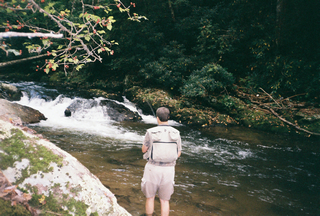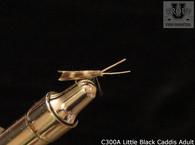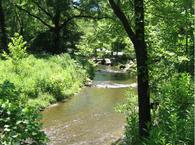
In Class 115, the student learned about different types of casting accuracy (distance accuracy vs. left and right accuracy), as well as some of the fishing situations that demand them. In this class, the student will learn some of the mechanical techniques that contribute to accuracy. Upon completion of this class, the student should be able to fine tune his casting, and with practice, expect to experience an improvement in the ratio of strikes per 100 casts.

The Author with Joan Wulff and Mell Krieger casting at San Francisco's famed Golden Gate Casting Club in 1986.
In order for the fly to land on target, the unrolling loop of fly line and leader must carry it there. Since the path of the loop follows the path of the rod tip, the key element in achieving casting accuracy is to drive the rod tip on a line pointed at the target. I teach this to students by getting them to look at the target and make an overhead cast (at least on the forward stroke) down their line of sight. This may seem very basic, but many of the accuracy problems I see on the stream result from excessively sidearm casting motions. Many self-taught casters learn by trial and error to minimize the effects of tailing loops by canting the rod to the side. Canting the rod doesn't cure tailing loops, but it does keep the line and leader from tangling, since the crossed loops unroll alongside (rather than on top of) one another. With enough practice, a sidearm caster can achieve accuracy, but a sidearm approach fails to take advantage of the natural accuracy that comes from casting directly down one's line of sight.
Joan Wulff, in her excellent book Fly-Casting Accuracy (The Lyons Press, 1997, 96 pages), uses the term "eye/target line" to refer to line of sight and "hand/target line" as the path the caster's hand takes to drive the rod tip toward the target. On short casts, where the casting stoke is short and the casting arc narrow, the caster can keep his hand in front of his head (and eyes), and these two lines coincide. On longer casts, where a longer stoke is required, the range of motion of the caster's hand and arm will move to the side, in front of or alongside the shoulder. As the eye/target line and hand/target line become separated, an "accuracy triangle" is created, with these two imaginary lines meeting at the target.
While this is an insightful conceptualization of the components of accuracy, my own experience in teaching casting is that many students — especially beginners and intermediates — fail to control the connection between the hand/target line and the path of rod tip during the casting stroke. Obviously, these two paths are connected, but for many casters, lack of control of angles (and muscles) at the hand, wrist, and elbow means that they can move their hand toward the target without being able to drive the rod tip (and line, leader, and fly) in exactly the same direction.
In my view, this is a general failing of much casting instruction: we try to teach mechanics (stance, grip, angles of wrist and elbow, size of the casting arc, etc.) to students who don't understand their relationship to the path of the rod tip — and ultimately, what really matters — control of the casting loop. Students are sure they are going through the right motions, but the line still refuses to go where it is supposed to. I find that many casters achieve greater accuracy and control by visualizing the path of the rod tip itself, adjusting hand and arm position as necessary to drive the tip down one's line of sight. In other words, I make the rod tip path the primary focus of instruction and the hand/target line secondary.
In many small creek situations, where smaller water and a careful approach allow shorter presentations, accuracy is simpler because the casting motion can be made in front of the body, and (as noted above) the caster's line of sight, the hand/target line, and path of the rod tip can all be lined up in the same vertical plane. If the caster separates the plane of the back cast and forward cast, he should make the back cast slightly sidearm and bring the forward cast right down the line of sight for better accuracy. On longer casts, longer strokes may require a greater separation of backcast and forward cast planes (in Wulff's terms, the legs of the accuracy triangle are moved farther apart), and a more dramatic repositioning at the end of the backcast stroke will be required. The principle remains the same, however — make the sidearm motion on the backcast and bring the rod tip back over the line of sight on the forward cast.
Although short presentations minimize the horizontal parallax between line of sight and the path of the rod tip (i.e., there is little separation between these lines), vertical parallax is increased, since the casting arc (and the rod tip path that creates it) must be tilted steeply downward to reach a nearby target. Note that this parallax is increased even more with longer rods. I refused to believe Tom Morgan's advice for years, but I now agree that shorter rods are more accurate for short range fishing. Although I still prefer an 8 1/2 foot rod as an all around fly fishing rod (and a 9 footer on big tailwaters like the Missouri or Bighorn), I find a 7 foot rod to be ideal for small mountain streams or tiny creeks. The advantages of short rods repeated in dozens of angling texts — more portability when hiking through brush and easier false casting under overhanging branches—are valid, but they are not nearly as important as the accuracy afforded by moving the path of the rod tip closer to the caster's line of sight.
Practice, of course, is the key to achieving consistent accuracy. One way to do this is to incorporate targets into at least part of every practice session. Paper plates weighted with a rock work fine, and fluorescent tennis balls can be tossed to a variety of positions on the lawn. In many cases, there are plenty of natural targets to choose from: a dandelion blossom, a fallen leaf, a bit of foam or floating weed on a pond. To practice "left and right" accuracy, try casting along a straight line target, like the edge of a sidewalk, the sideline of a football field, or a garden hose stretched across a lawn. Be sure to add a piece of brightly colored yarn to the end of the leader for practice sessions. The line and leader will turn over more realistically, and the yarn will allow the caster to check accuracy on each presentation.
Joan Wulff's "pick a leaf" practice is another excellent way to hone accuracy skills. For this practice, Wulff recommends picking a small target, like an individual leaf in a hedge, and trying to touch the target with the practice fly, working in various casting planes, both forehand and backhand, and at various distances. One of the keys to this practice is to concentrate on a pinpoint target.
The ultimate goal for the angler is to reach the point where accuracy is fully integrated with other casting skills, where there is no thought about casting mechanics, no consideration of the line of sight or rod tip path or casting arcs. The angler simply looks at the target, makes the cast, and the fly lands exactly where it is aimed. This requires practice, but the practice has rewards: casting accuracy not only catches a lot of fish, it is one of the most satisfying parts of the fly caster's game.
To further improve your casting ability, execute the methods of practice explained in class. This is a difficult class and the student will need the practice. Remember to use yarn to prevent injury.
Check out the instructor's web site.
Note: Class material first appeared in Mid Currents.





